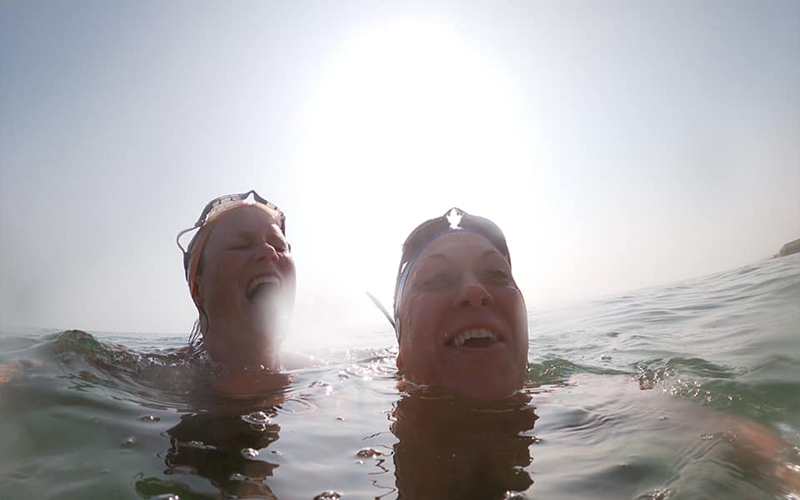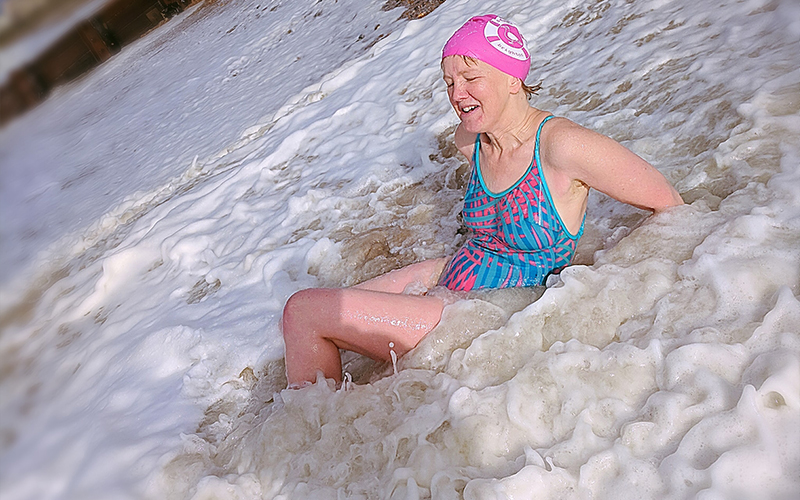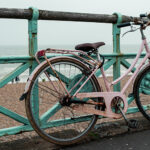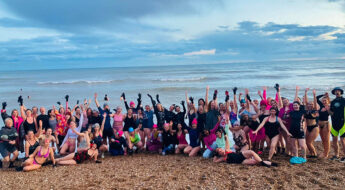Ok, it’s officially cold outside (hello, frost!), but does that mean you should abandon the fun of sea swimming in Brighton until next summer? No, of course not! Cold-water swimming has many positive health effects and some people swim all year round whatever the weather, not least those who are part of the Brighton-based Seabirds social enterprise and swimming community.
But of course there are other factors to take into consideration when swimming in cold water, especially if you’re new to it. That’s where the lovely Seabirds come in – we’re big fans of their swimming shop and their community. We were delighted when co-founder and regular sea swimmer Catherine Brown kindly agreed to write the following piece for us. Here she is sharing her expertise so we can all get a few wintry swims in safely (we don’t know about you, but we’re determined this year!)…
Cold water sea swimming – kill or cure?
The clocks have gone back, it is officially Cold Water Swimming season. But how do you do it safely?
Many people believe in the healing power of cold water for both body and mind. But cold water does not come without its risks. Even in the summer months swimmers can experience cold water shock. So how do you make sure your cold water swim is the cure you are looking for? After three years of year-round skin sea swimming in Brighton and Hove, this is what the Seabirds have learnt.
Why do it?
There are lots of reasons and lots of research into cold water swimming and why people do it. People might be looking for a cure for depression, anxiety, physical pain or discomfort. It’s a great group activity and creates community and camaraderie. It’s time away from the fast pace of modern-day living. And, exposing yourself regularly to stress, by swimming in cold water allows your body and mind to adapt to dealing with stress in daily situations. Yes, there is pain to begin with, alongside a lot of profanities, but sharing the experience with other swimmers is fun and you get to eat cake afterwards [Ed: we love this bit]!

How can you do it safely?
- Be self-aware
The most important skill you need for cold water swimming is self-awareness. If you’re looking to push your limits, do it gradually. This isn’t about your swim experience and abilities. This is about how you feel on the day. Ask yourself these questions: have you eaten, do you feel physically and mentally well, do you have an injury. All of these factors need to be considered before entering the water. - Swim in groups
Swimming in groups is always a win. Firm friendships are formed in the sea. But do not rely on others to advise you whether it is safe to swim or if you are capable of a completing a swim. You are responsible for your own safety and your own swim, as are your fellow swimmers. - Check conditions
Check conditions before AND during your swim. There are lots of apps that help you do this before your swim and, when in the water, be mindful of potentially changing sea, tide and weather. Regularly take a rest and check the environment. If you need to, change your swim, cut it short, do it a different day. - Check water temperature
Knowing the temperature of the water can be useful but it should be just one of your checks before you swim. There is no hard and fast rule about how long you can stay in for and when or if you should start wearing neoprene. This again comes back to self-awareness. Doing it regularly helps with adaptation. - Acclimatise yourself to the cold
Acclimatisation in the first few minutes is key to a safe swim. Your body’s response to cold water is fight or flight. Your heart rate increases and you will struggle to catch your breath. This in turn can cause swimmers to panic. The key is to immerse yourself slowly, control your breathing and float until you feel it pass. You are then set to start your swim. - Get to know the swim area
Getting to know your sea swim spot is an important part of cold water swimming. Swimmers can be overcome by the cold water temperatures during a swim, so sticking close to a safe exit point, i.e. the shore, is a good choice. Make sure you have the skills to get out via breaking waves, too. Some beaches in the city are easier to navigate than others. Hove has lots of groynes making the currents close to shore a bit slower. All of the beaches are shingle, which moves, so the beach will be different every day and at different tides. - Distance doesn’t matter
Don’t be concerned with distance covered or time in the water. On a different day at the same temperature you may only manage half of what you usually do. There is still cake afterwards. - Consider a wetsuit
Wearing a wetsuit doesn’t remove cold water shock, cold water still needs to trickle in before it warms up, but it does dull the pain. They are designed to keep you warmer for longer so can increase the time you spend in the water. They also help you float which is only ever a good thing. If you have decided skin swimming (cossie only) is for you then you can wear neoprene accessories to keep your extremities warm. - Keep moving
And as Dory says – “Just keep swimming“. As the sea temperature drops, face in freestyle may become less possible but movement is just as important. The less you move your body, the quicker the cold will affect you. If you are struggling to keep moving, it could be the start of cold incapacitation and it is time to get out. Remember cold can overwhelm swimmers very suddenly.

How to get warm
Get dressed as quickly as possible. Lots of thin layers. We lay all of our clothes out in the order we will be putting them on and wrap the first few layers in a hot water bottle. Nothing tight fitting or fiddly. Fingers are too numb for bra fastening and we rarely remember our knickers! Check out our online shop for bits of kit such as core warmers, sports cloaks and our iconic woolly hats. These are the hats and robes we use to identify fellow Seabirds on Brighton beach in the winter.
Move around and keep moving long after your swim. It will take your body a while to warm up and it needs to do it from the inside out. Hot water bottles and blankets warm up your surface and trick the brain into thinking it no longer needs to focus or warming up your core. You may also experience the dreaded ‘after-drop’ as your core temperature can continue to drop after you have exited the water. Also try to avoid hot baths and showers for a while until you have warmed up from the inside.
Drink something hot and eat cake!
We have found that it’s ALWAYS worth getting in – your mood shifts positively – being part of a swim community [Ed: there’s a swim every day and they’re a very friendly bunch] like our Seabirds helps to keep getting you out and down the beach (when you might just feel like hibernating!). Do have a look at our online Wild Swim Shop – with everything you need to face the cold water! As a social enterprise, all profits from sales go towards funding our work – getting more people into the sea to improve their wellbeing, ‘salted wellbeing’!











Recent Comments